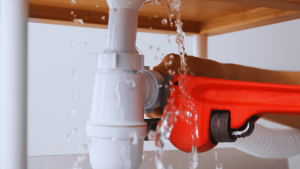Installing a kitchen backsplash tile is a great way to give your kitchen a fresh, updated look. But, if you’re not familiar with the installation process, it can seem daunting. That’s why we’ve created this step-by-step guide to help you install your very own kitchen backsplash tile. In this guide, we’ll cover everything you need to know, from gathering the necessary tools and materials to applying the grout and cleaning the finished product. With these kitchen backsplash tile installation tips, you’ll have a stunning new backsplash in no time!
Key Takeaways:
- Installing a kitchen backsplash tile can update the look of your kitchen.
- Following the proper installation techniques is important for a successful project.
- Gathering the necessary tools and materials is the first step in the installation process.
Gather the Necessary Tools and Materials
Before beginning your kitchen backsplash tile installation project, it’s important to gather all the necessary tools and materials to ensure a smooth and efficient process. Here’s a list of what you’ll need:
| Tools | Materials |
|---|---|
| Tape measure | Tile adhesive |
| Level | Backsplash tiles |
| Trowel | Tile spacers |
| Tile cutter or wet saw | Grout |
| Grout float | Grout sealer (optional) |
| Bucket | Clean, dry rags |
If you’re planning to DIY your kitchen backsplash tile installation, it’s important to have all the tools and materials at your disposal. This will ensure that you don’t have to stop midway and make a trip to the hardware store. By having everything ready, you can dedicate your time and focus on the installation itself.
Measure and Prepare the Backsplash Area
Before starting the tiling process, it’s essential to measure and prepare the backsplash area properly. Following the best practices for kitchen backsplash tile installation will ensure a durable, flawless installation that will last for years to come.
Measure the Backsplash Area
The first step in preparing the backsplash area is to measure it carefully. Measure the length and height of the area, and calculate the square footage you’ll need to cover. This will help you determine how many tiles you’ll need to purchase.
It’s always a good idea to purchase a few extra tiles in case of mistakes or cuts that don’t turn out as planned.
Prepare the Surface
Before laying the tiles, it’s crucial to prepare the surface properly. Start by cleaning the area thoroughly to remove any dirt, grease, or debris. Use a degreasing cleaner to ensure a clean and smooth surface. Rinse the area with clean water and let it dry completely.
Next, prime the surface with a high-quality primer that is suitable for the material you’re working with. This will create a strong and even bond between the surface and the tiles.
By following these best practices for kitchen backsplash tile installation, you’ll create a stable and durable foundation that will make the tiling process smoother and more successful.
Lay Out the Tile Pattern
Creating a tile layout is an essential step in the kitchen backsplash tile installation process. It ensures a visually pleasing and balanced design that will enhance the overall look of your kitchen. Follow our step-by-step guide below for an easy and successful installation.
Step 1: Determine Tile Placement
Start by placing a row of tiles along the bottom of the backsplash area. Use tile spacers to ensure even spacing between each tile. Adjust the placement as needed to avoid having small or thin tiles at the edges of the installation area.
Step 2: Create a Centerline
Use a carpenter’s level to create a centerline that runs vertically through the middle of the installation area. This line will help guide the placement of the tiles, ensuring they are evenly distributed on each side of the backsplash.
Step 3: Start Tiling
Begin tiling at the centerline, applying adhesive to the back of each tile and pressing it firmly into place. Use tile spacers between each tile to ensure even spacing. Continue tiling outward from the centerline, working in small sections and periodically checking the level to ensure the tiles are even.
Step 4: Cut Tiles to Fit
At some point, you will need to cut tiles to fit around any obstacles in the backsplash area, such as electrical outlets or windows. Measure carefully and mark the tiles that need to be cut. Use a tile cutter or tile saw to make the necessary cuts and ensure a clean edge.
By following these simple steps for laying out the tile pattern, you’ll ensure a beautiful and well-balanced backsplash. Keep on reading to learn how to apply adhesive and install the tiles in section 5.
Apply the Adhesive and Install the Tiles
With the layout finalized, it’s time to apply the adhesive and install the tiles. Begin by spreading adhesive on a small section of the backsplash area, using the notched trowel to create grooves in the adhesive. This will ensure the tiles have a strong bond with the surface.
Start placing the tiles at the bottom of the backsplash and work your way upwards. Press each tile firmly into the adhesive, making sure it’s level and evenly spaced from the surrounding tiles. Check the alignment regularly to avoid shifting or uneven tiles.
For best results, work in small sections to ensure the adhesive remains pliable and doesn’t dry out. If any adhesive seeps through the gaps between the tiles, use a toothpick or damp cloth to remove it immediately.
Once all the tiles have been installed, allow the adhesive to set for 24 hours before proceeding to the next step.
Kitchen Backsplash Tile Installation Tips
- Ensure the adhesive is evenly spread to avoid lumps or bumps in the tile surface.
- Work in small sections to prevent the adhesive from drying out too quickly.
- Regularly check the alignment of the tiles to ensure they’re straight and evenly spaced.
- Use spacers to create consistent gaps between the tiles for a professional look.
- Wipe away any excess adhesive immediately to avoid it drying on the surface.
DIY Kitchen Backsplash Tile Installation
Installing a kitchen backsplash tile is a DIY project that can be completed by anyone with basic tiling skills. By following these simple steps and tips, you can achieve a professional-looking backsplash that enhances the beauty and functionality of your kitchen.
Cut Tiles to Fit Around Obstacles
Once all full tiles have been installed, it’s time to measure and cut tiles to fit around any obstacles such as electrical outlets, windows, or cabinets. This step is critical to achieving a professional and seamless finish.
Before cutting any tiles, measure the area where the tile needs to fit and mark the tile accordingly. Use a tile cutter or wet saw to cut the tile along the marked line. Be sure to wear eye protection and follow the manufacturer’s instructions for using the cutting tool.
Best Practices for Cutting Tiles
It’s important to cut accurately to ensure a proper fit. Here are a few best practices for cutting tiles:
- Measure twice before making a cut to ensure accuracy
- Start with small cuts and make adjustments as needed
- Use a wet saw for larger or irregular cuts
- Use a tile cutter for straight cuts
- Sand any rough edges with a sandpaper or a tile file
Once all tiles have been cut to fit around obstacles, allow the tiles to set and dry completely before proceeding to the grouting stage.
Allow the Tiles to Set and Dry
After the tiles are installed, it is important to allow them to set and dry for at least 24 hours before proceeding to the grouting stage. This will ensure that the tiles are firmly set in place and will not shift or move during the grouting process.
During this time, it is best to avoid touching or disturbing the tiles as much as possible. This will prevent any accidental shifting or movement that can occur during the drying process.
Once the tiles are set and dry, you can move on to the next step of the installation process with confidence, knowing that your tiles are properly secured and ready for the next stage.
Apply Grout to the Tiles
After allowing the adhesive to dry for at least 24 hours, it’s time to apply grout to the tiles. Grout not only fills the gaps between the tiles, but it also helps to secure them in place. Here are some best practices for applying grout:
- Wear gloves and eye protection to avoid skin and eye irritation from the grout.
- Mix the grout according to the manufacturer’s instructions, using a trowel or mixing attachment on a drill.
- Starting at one corner of the backsplash, use a grout float to spread the grout across the tiles at a 45-degree angle. Press the grout firmly into the gaps between the tiles, working in small sections.
- Use a damp sponge to remove excess grout from the surface of the tiles, rinsing frequently in clean water.
- After the grout has set for about 10-15 minutes, use a clean, damp sponge to wipe away any remaining haze or residue from the tiles.
- Allow the grout to dry completely, usually for about 24-48 hours depending on the manufacturer’s instructions.
Following these simple steps will ensure a clean and professional-looking grout application. Remember to read the manufacturer’s instructions carefully, as different types of grout may have specific requirements for mixing and application. With a little patience and attention to detail, your DIY kitchen backsplash tile installation project will be a success.
Seal the Grout (Optional)
After the grout has been allowed to dry completely, it is recommended to apply a sealer to help protect it from stains and discoloration, especially in areas where water or food will be present. Apply the grout sealer to a clean surface using a small brush or roller, lightly coating the grout lines. Allow the sealer to dry for the recommended time on the package before applying a second coat if necessary.
Using a grout sealer is an optional step, but it can provide a layer of protection and prolong the life of your kitchen backsplash. Remember to always follow the manufacturer’s instructions when using any sealant or cleaning product.
Kitchen Backsplash Tile Installation Tips:
- Always wear gloves and protective eyewear when working with grout and sealant.
- Make sure the area is well-ventilated when applying sealant.
- Choose a high-quality grout sealer for best results.
Professional Tips for Successful Kitchen Backsplash Tile Installation:
- Wait at least 24-48 hours after grouting before applying the sealer.
- Apply the sealer in a well-lit area to ensure even coverage.
- Use a small brush or roller to apply the sealer to avoid getting it on the tile surface.
Clean and Finishing Touches
Now that you have completed the tile installation, it’s important to ensure that the tiles are cleaned and any necessary finishing touches are made for a polished look. Here are some common mistakes to avoid:
- Skipping the Cleaning Process: Don’t skip the cleaning process! Use a damp sponge to wipe the tiles clean and remove any excess adhesive or grout from the tiles and joints.
- Not Checking for Grout Haze: After the grout has dried, check for grout haze. If the tiles appear cloudy, use a clean, dry cloth to buff the haze away.
- Forgetting Sealing: If you have opted to seal your grout, make sure to do so after the grout has completely dried. Follow the instructions on the sealer to ensure proper application.
- Not Inspecting for Loose or Uneven Tiles: Inspect the installed tiles for any loose or uneven tiles. If any are found, carefully remove them and reinstall with fresh adhesive.
With these common mistakes in mind, give your backsplash a final review before enjoying your newly transformed kitchen!
Conclusion
Installing a kitchen backsplash tile can seem like a daunting task, but by following these step-by-step instructions, it can be a manageable and even enjoyable DIY project. Begin by gathering all the necessary tools and materials, measuring and preparing the backsplash area, laying out the tile pattern, applying the adhesive and installing the tiles, cutting tiles to fit around obstacles, allowing the tiles to set and dry, applying grout to the tiles, and sealing the grout if desired. Finally, clean and add finishing touches to ensure a polished and professional-looking kitchen backsplash.
Remember, proper installation techniques are crucial to the longevity and durability of your backsplash. By investing the time and effort to install your backsplash correctly, you’ll save yourself the headache of costly repairs down the road. So, whether you’re a seasoned DIYer or a beginner, with these kitchen backsplash tile installation tips, you’ll be able to create a beautiful and functional backsplash that will enhance the look and feel of your entire kitchen.
Happy Tiling!
FAQ
Q: What tools and materials do I need for kitchen backsplash tile installation?
A: You will need adhesive, tiles, a trowel, grout, a tile cutter, a sponge, and a grout float, among other tools and materials.
Q: How do I measure and prepare the backsplash area?
A: Start by measuring the area where the backsplash will be installed and clean the surface thoroughly. Then, apply a primer to ensure proper adhesion.
Q: How do I create a tile layout for my backsplash?
A: Begin by finding the center point of the wall and then create a vertical and horizontal guide line. Use these lines to lay out the tiles in a visually pleasing pattern.
Q: How do I apply adhesive and install the tiles?
A: Apply adhesive to the backsplash area using a trowel and press the tiles firmly into place. Make sure to maintain proper spacing and alignment.
Q: How do I cut tiles to fit around obstacles?
A: Use a tile cutter or wet saw to carefully cut tiles to fit around outlets, windows, or other obstacles. Measure twice and cut once to ensure accuracy.
Q: How long do I need to let the tiles set and dry?
A: It is important to allow the tiles to set and dry for at least 24 hours before proceeding to the grouting stage. This will ensure a strong and durable installation.
Q: How do I apply grout to the tiles?
A: Use a grout float to apply grout to the tiles, working it into the gaps between them. Remove excess grout with a damp sponge, wiping diagonally across the tiles.
Q: Should I seal the grout?
A: Sealing the grout is optional but recommended for added protection against stains and moisture. Apply a grout sealer according to the manufacturer’s instructions.
Q: How do I clean the installed tiles and add finishing touches?
A: Clean the tiles with a mild cleaner and a sponge, avoiding abrasive materials. Consider adding a tile trim or caulk around the edges for a polished look.

It’s me, Amber Hayden, the heart and soul behind SagarmathaOnlineMedia.com. From a young age, I’ve been head over heels for everything home-related, from interior decor to gardening. I’m the type who can’t resist a well-crafted piece of furniture, and I firmly believe that a home isn’t complete without a pet or two. But it’s not just about creating pretty spaces for me. I’m all about making homes that tell a story reflecting the people living there. SagarmathaOnlineMedia.com is my way of sharing this passion with you. Whether you’re looking for tips to jazz up your living room, advice on pet care, or ideas to make your garden bloom, I’m here to help. So, let’s embark on this journey together and make your house a home!



